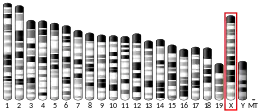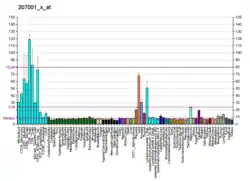TSC22D3
TSC22 domain family protein 3 is a protein that in humans is encoded by the TSC22D3 gene.[5][6]
Function
The protein encoded by this gene shares significant sequence identity with the murine TSC-22 and Drosophila shs, both of which are leucine zipper proteins, that function as transcriptional regulators. GILZ shows ubiquitous expression across tissues, including thymus, spleen, lung, fat, liver, kidney, heart, and skeletal muscle.[7][8] The expression of this gene is stimulated by glucocorticoids and interleukin 10, and it appears to play a key role in the anti-inflammatory and immunosuppressive effects of this steroid and chemokine. Transcript variants encoding different isoforms have been identified for this gene.[6]
References
- GRCh38: Ensembl release 89: ENSG00000157514 - Ensembl, May 2017
- GRCm38: Ensembl release 89: ENSMUSG00000031431 - Ensembl, May 2017
- "Human PubMed Reference:". National Center for Biotechnology Information, U.S. National Library of Medicine.
- "Mouse PubMed Reference:". National Center for Biotechnology Information, U.S. National Library of Medicine.
- Vogel P, Mägert HJ, Cieslak A, Adermann K, Forssmann WG (Dec 1996). "hDIP--a potential transcriptional regulator related to murine TSC-22 and Drosophila shortsighted (shs)--is expressed in a large number of human tissues". Biochimica et Biophysica Acta (BBA) - Gene Structure and Expression. 1309 (3): 200–4. doi:10.1016/s0167-4781(96)00177-7. PMID 8982256.
- "Entrez Gene: TSC22D3 TSC22 domain family, member 3".
- Ayyar, Vivaswath S.; Almon, Richard R.; Jusko, William J.; DuBois, Debra C. (2015-06-01). "Quantitative tissue-specific dynamics of in vivo GILZ mRNA expression and regulation by endogenous and exogenous glucocorticoids". Physiological Reports. 3 (6): e12382. doi:10.14814/phy2.12382. PMC 4510616. PMID 26056061.
- Cannarile, L.; Zollo, O.; D'Adamio, F.; Ayroldi, E.; Marchetti, C.; Tabilio, A.; Bruscoli, S.; Riccardi, C. (2001-02-01). "Cloning, chromosomal assignment and tissue distribution of human GILZ, a glucocorticoid hormone-induced gene". Cell Death and Differentiation. 8 (2): 201–203. doi:10.1038/sj.cdd.4400798. ISSN 1350-9047. PMID 11313722.
- Ayroldi E, Zollo O, Macchiarulo A, Di Marco B, Marchetti C, Riccardi C (Nov 2002). "Glucocorticoid-induced leucine zipper inhibits the Raf-extracellular signal-regulated kinase pathway by binding to Raf-1". Molecular and Cellular Biology. 22 (22): 7929–41. doi:10.1128/MCB.22.22.7929-7941.2002. PMC 134721. PMID 12391160.
- Ayroldi E, Migliorati G, Bruscoli S, Marchetti C, Zollo O, Cannarile L, D'Adamio F, Riccardi C (Aug 2001). "Modulation of T-cell activation by the glucocorticoid-induced leucine zipper factor via inhibition of nuclear factor kappaB". Blood. 98 (3): 743–53. doi:10.1182/blood.V98.3.743. PMID 11468175.
Further reading
- Andersson B, Wentland MA, Ricafrente JY, Liu W, Gibbs RA (Apr 1996). "A "double adaptor" method for improved shotgun library construction". Analytical Biochemistry. 236 (1): 107–13. doi:10.1006/abio.1996.0138. PMID 8619474.
- Yu W, Andersson B, Worley KC, Muzny DM, Ding Y, Liu W, Ricafrente JY, Wentland MA, Lennon G, Gibbs RA (Apr 1997). "Large-scale concatenation cDNA sequencing". Genome Research. 7 (4): 353–8. doi:10.1101/gr.7.4.353. PMC 139146. PMID 9110174.
- Wiemann S, Weil B, Wellenreuther R, Gassenhuber J, Glassl S, Ansorge W, Böcher M, Blöcker H, Bauersachs S, Blum H, Lauber J, Düsterhöft A, Beyer A, Köhrer K, Strack N, Mewes HW, Ottenwälder B, Obermaier B, Tampe J, Heubner D, Wambutt R, Korn B, Klein M, Poustka A (Mar 2001). "Toward a catalog of human genes and proteins: sequencing and analysis of 500 novel complete protein coding human cDNAs". Genome Research. 11 (3): 422–35. doi:10.1101/gr.GR1547R. PMC 311072. PMID 11230166.
- Cannarile L, Zollo O, D'Adamio F, Ayroldi E, Marchetti C, Tabilio A, Bruscoli S, Riccardi C (Feb 2001). "Cloning, chromosomal assignment and tissue distribution of human GILZ, a glucocorticoid hormone-induced gene". Cell Death and Differentiation. 8 (2): 201–3. doi:10.1038/sj.cdd.4400798. PMID 11313722.
- Mittelstadt PR, Ashwell JD (Aug 2001). "Inhibition of AP-1 by the glucocorticoid-inducible protein GILZ". The Journal of Biological Chemistry. 276 (31): 29603–10. doi:10.1074/jbc.M101522200. PMID 11397794.
- Ayroldi E, Migliorati G, Bruscoli S, Marchetti C, Zollo O, Cannarile L, D'Adamio F, Riccardi C (Aug 2001). "Modulation of T-cell activation by the glucocorticoid-induced leucine zipper factor via inhibition of nuclear factor kappaB". Blood. 98 (3): 743–53. doi:10.1182/blood.V98.3.743. PMID 11468175.
- Ayroldi E, Zollo O, Macchiarulo A, Di Marco B, Marchetti C, Riccardi C (Nov 2002). "Glucocorticoid-induced leucine zipper inhibits the Raf-extracellular signal-regulated kinase pathway by binding to Raf-1". Molecular and Cellular Biology. 22 (22): 7929–41. doi:10.1128/MCB.22.22.7929-7941.2002. PMC 134721. PMID 12391160.
- Berrebi D, Bruscoli S, Cohen N, Foussat A, Migliorati G, Bouchet-Delbos L, Maillot MC, Portier A, Couderc J, Galanaud P, Peuchmaur M, Riccardi C, Emilie D (Jan 2003). "Synthesis of glucocorticoid-induced leucine zipper (GILZ) by macrophages: an anti-inflammatory and immunosuppressive mechanism shared by glucocorticoids and IL-10". Blood. 101 (2): 729–38. doi:10.1182/blood-2002-02-0538. PMID 12393603.
- Shi X, Shi W, Li Q, Song B, Wan M, Bai S, Cao X (Apr 2003). "A glucocorticoid-induced leucine-zipper protein, GILZ, inhibits adipogenesis of mesenchymal cells". EMBO Reports. 4 (4): 374–80. doi:10.1038/sj.embor.embor805. PMC 1319161. PMID 12671681.
- Asselin-Labat ML, David M, Biola-Vidamment A, Lecoeuche D, Zennaro MC, Bertoglio J, Pallardy M (Jul 2004). "GILZ, a new target for the transcription factor FoxO3, protects T lymphocytes from interleukin-2 withdrawal-induced apoptosis". Blood. 104 (1): 215–23. doi:10.1182/blood-2003-12-4295. PMID 15031210.
- Asselin-Labat ML, Biola-Vidamment A, Kerbrat S, Lombès M, Bertoglio J, Pallardy M (Jul 2005). "FoxO3 mediates antagonistic effects of glucocorticoids and interleukin-2 on glucocorticoid-induced leucine zipper expression". Molecular Endocrinology. 19 (7): 1752–64. doi:10.1210/me.2004-0206. PMID 15705665.
- Rual JF, Venkatesan K, Hao T, Hirozane-Kishikawa T, Dricot A, Li N, Berriz GF, Gibbons FD, Dreze M, Ayivi-Guedehoussou N, Klitgord N, Simon C, Boxem M, Milstein S, Rosenberg J, Goldberg DS, Zhang LV, Wong SL, Franklin G, Li S, Albala JS, Lim J, Fraughton C, Llamosas E, Cevik S, Bex C, Lamesch P, Sikorski RS, Vandenhaute J, Zoghbi HY, Smolyar A, Bosak S, Sequerra R, Doucette-Stamm L, Cusick ME, Hill DE, Roth FP, Vidal M (Oct 2005). "Towards a proteome-scale map of the human protein-protein interaction network". Nature. 437 (7062): 1173–8. Bibcode:2005Natur.437.1173R. doi:10.1038/nature04209. PMID 16189514. S2CID 4427026.
- Soundararajan R, Zhang TT, Wang J, Vandewalle A, Pearce D (Dec 2005). "A novel role for glucocorticoid-induced leucine zipper protein in epithelial sodium channel-mediated sodium transport". The Journal of Biological Chemistry. 280 (48): 39970–81. doi:10.1074/jbc.M508658200. PMID 16216878.
- Hamdi H, Godot V, Maillot MC, Prejean MV, Cohen N, Krzysiek R, Lemoine FM, Zou W, Emilie D (Jul 2007). "Induction of antigen-specific regulatory T lymphocytes by human dendritic cells expressing the glucocorticoid-induced leucine zipper". Blood. 110 (1): 211–9. doi:10.1182/blood-2006-10-052506. PMC 2077304. PMID 17356131.
This article is issued from Wikipedia. The text is licensed under Creative Commons - Attribution - Sharealike. Additional terms may apply for the media files.







